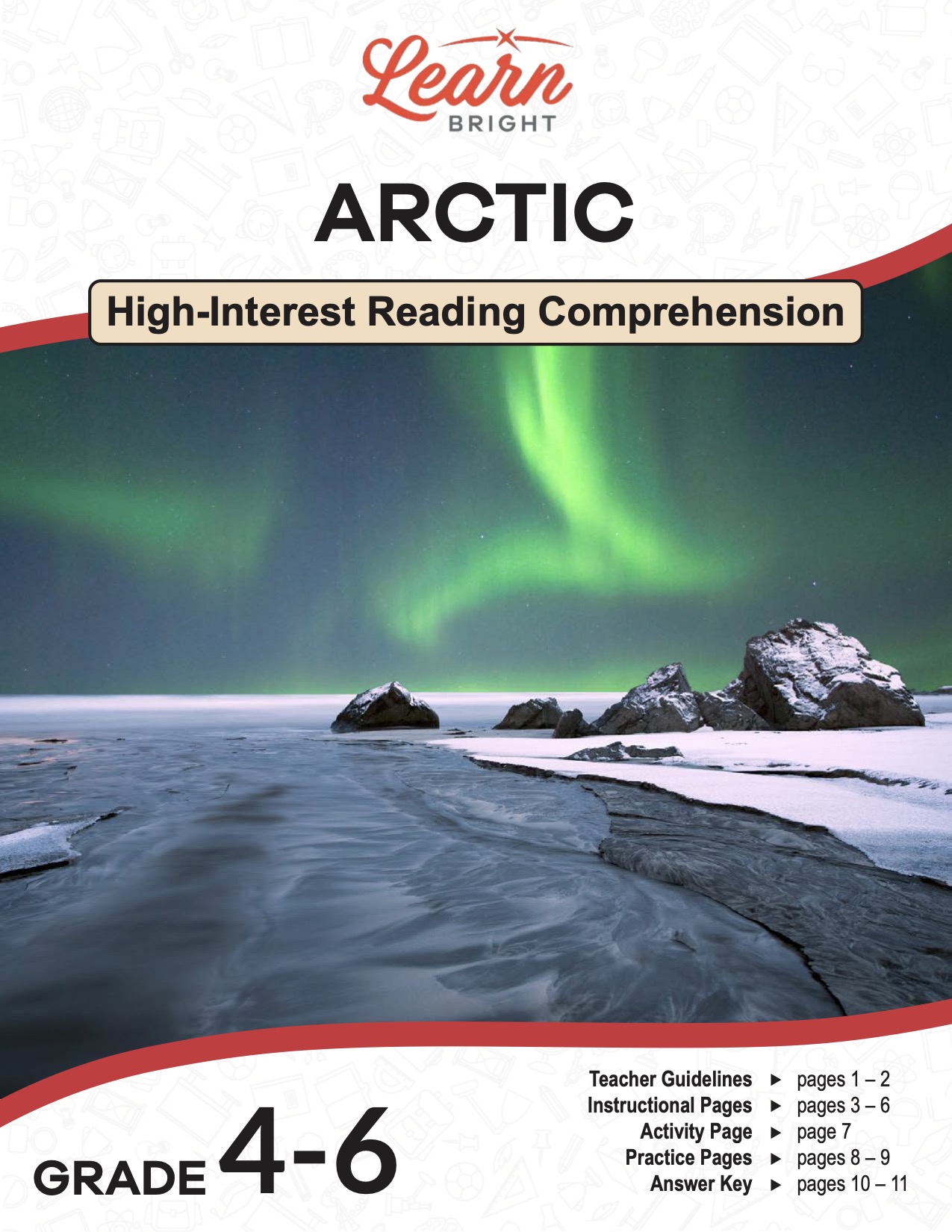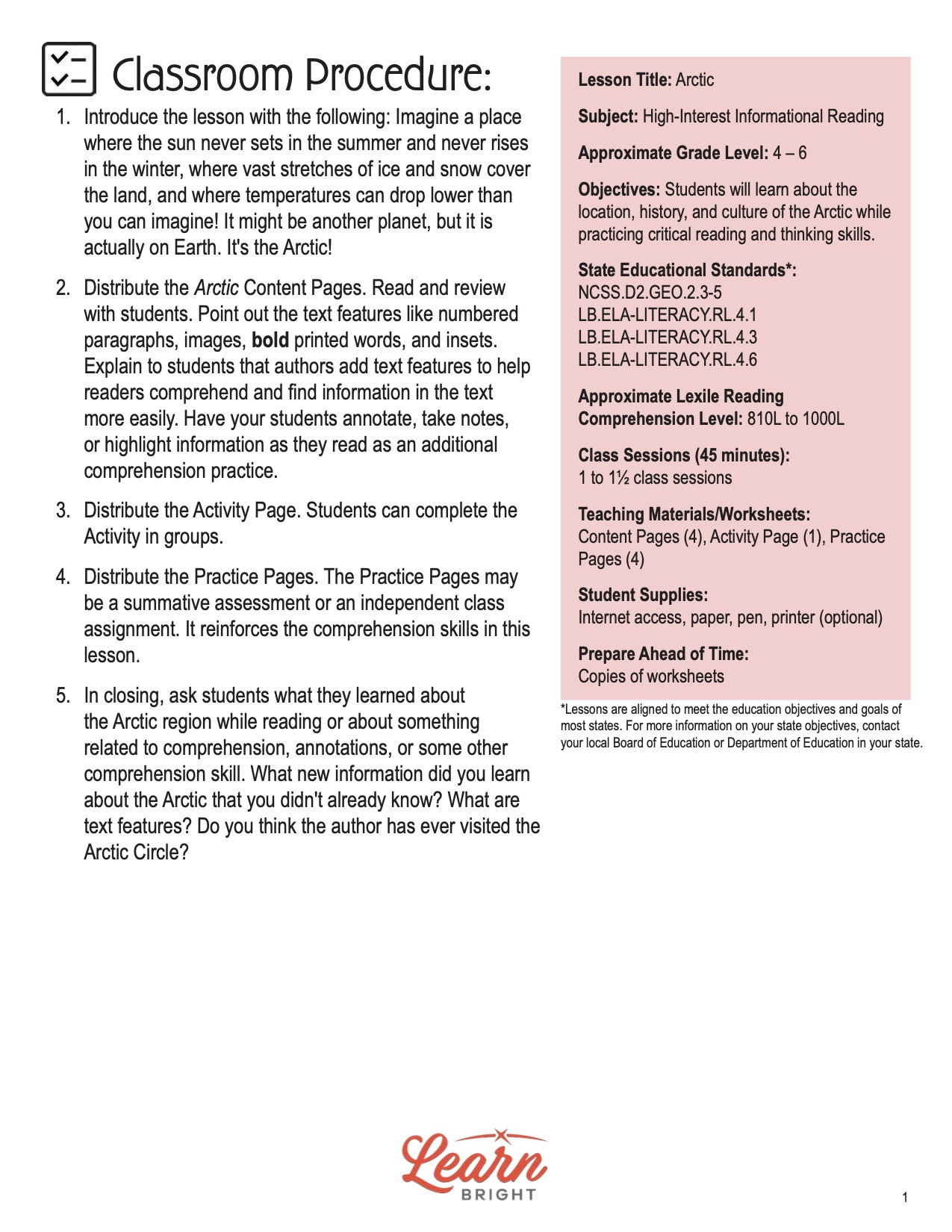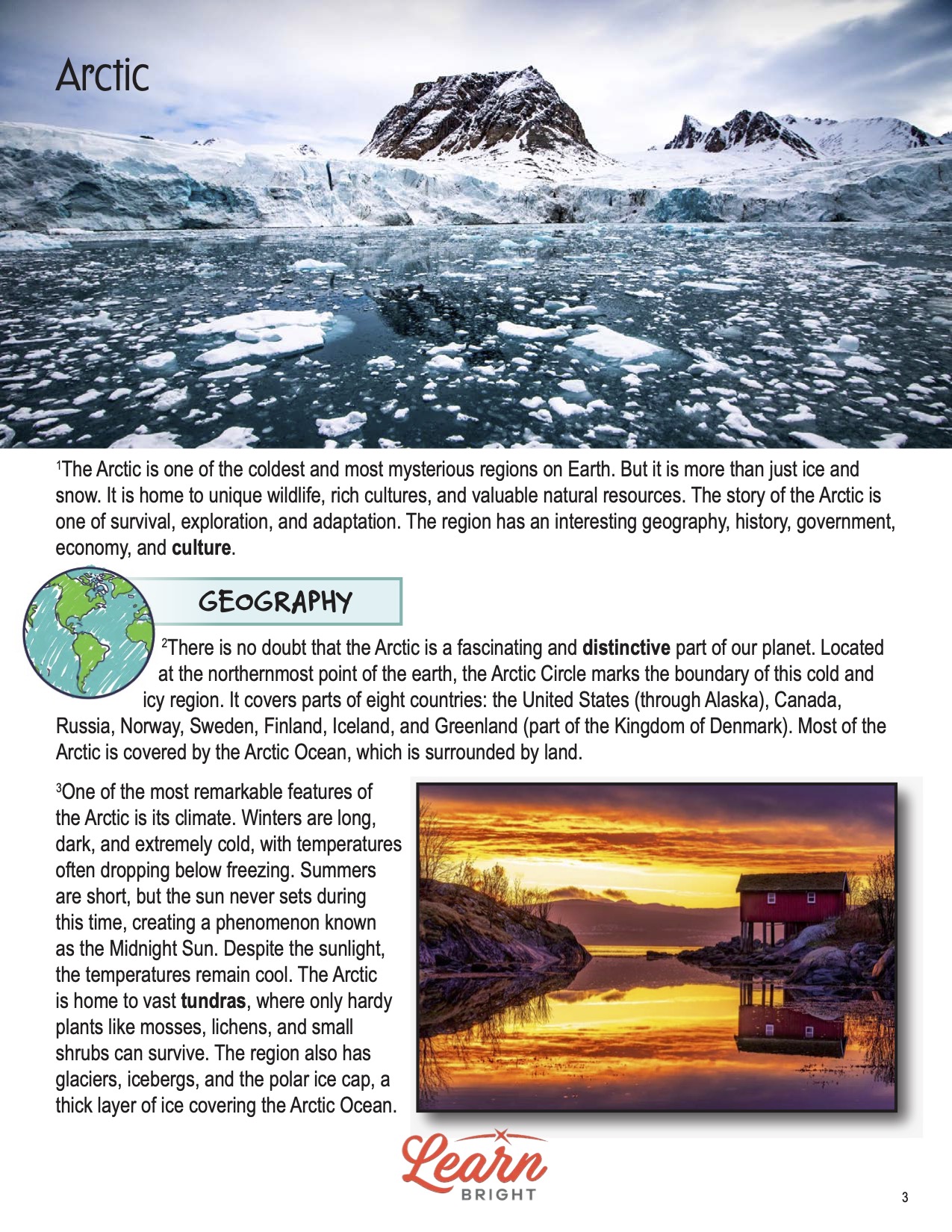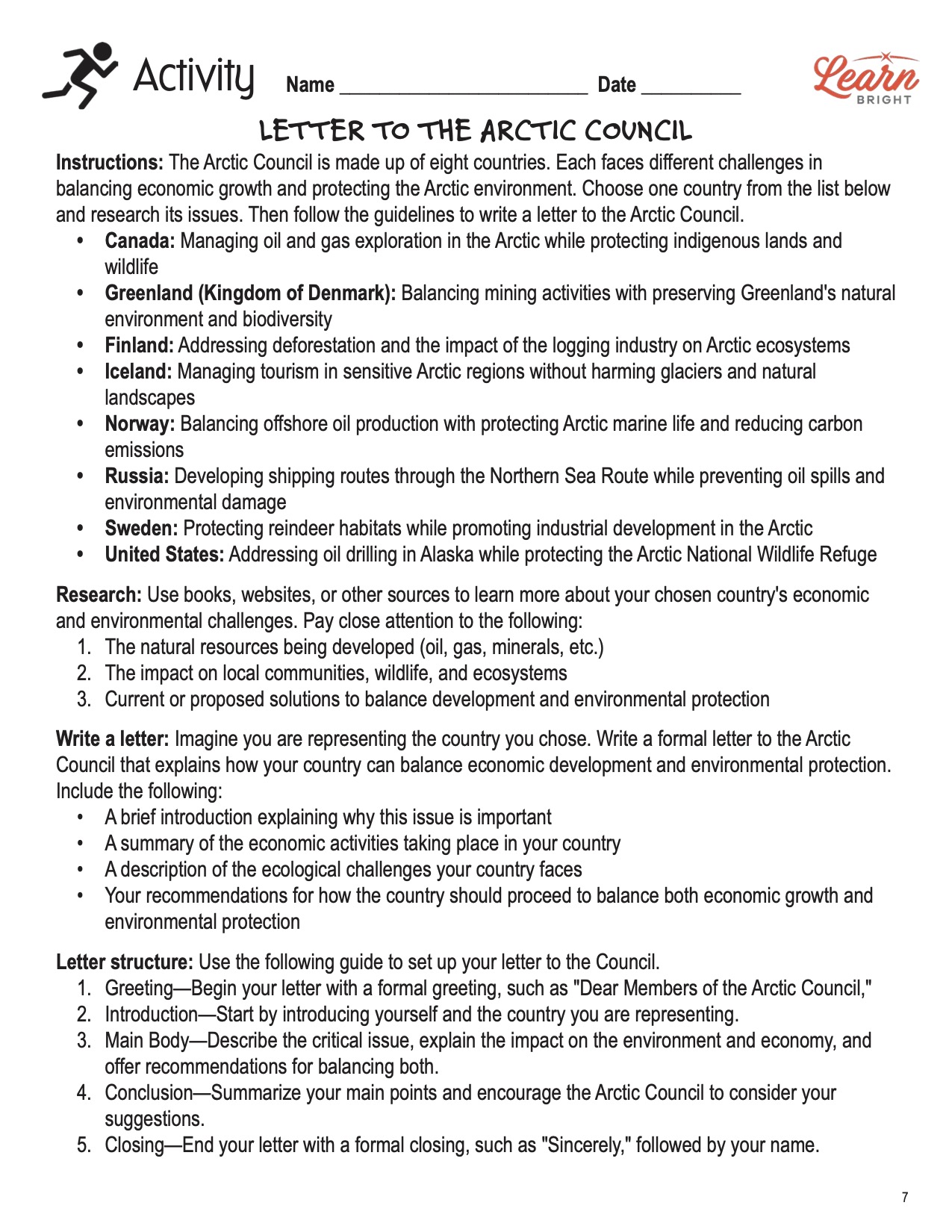Description
What our Arctic lesson plan includes
Lesson Objectives and Overview: Arctic is a high-interest reading comprehension lesson plan. As such, students will practice various close reading and comprehension skills. They will also learn about the location, history, and culture of the Arctic while practicing critical reading and thinking skills. This lesson is for students in 4th grade, 5th grade, and 6th grade.
Classroom Procedure
Every lesson plan provides you with a classroom procedure page that outlines a step-by-step guide to follow. You do not have to follow the guide exactly. The guide helps you organize the lesson and details when to hand out worksheets. It also lists information in the yellow box that you might find useful. You will find the lesson objectives, state standards, and number of class sessions the lesson should take to complete in this area. In addition, it describes the supplies you will need as well as what and how you need to prepare beforehand.
Teacher Notes
The paragraph on this page gives you a little more information on the lesson overall and describes what you may want to focus your teaching on. It explains that you can teach this lesson in a whole-class setting or as an independent, small-group activity. The blank lines are available for you to write out any thoughts or ideas you have as you prepare.
ARCTIC LESSON PLAN CONTENT PAGES
The Arctic lesson plan contains four content pages. The Arctic is one of the coldest and most mysterious regions on Earth. But it is more than just ice and snow. It is home to unique wildlife, rich cultures, and valuable natural resources. The story of the Arctic is one of survival, exploration, and adaptation. The region has an interesting geography, history, government, economy, and culture.
Geography
There is no doubt that the Arctic is a fascinating and distinctive part of our planet. Located at the northernmost point of the earth, the Arctic Circle marks the boundary of this cold and icy region. It covers parts of eight countries: the United States (through Alaska), Canada, Russia, Norway, Sweden, Finland, Iceland, and Greenland (part of the Kingdom of Denmark). Most of the Arctic is covered by the Arctic Ocean, which is surrounded by land.
One of the most remarkable features of the Arctic is its climate. Winters are long, dark, and extremely cold, with temperatures often dropping below freezing. Summers are short, but the sun never sets during this time, creating a phenomenon known as the Midnight Sun. Despite the sunlight, the temperatures remain cool. The Arctic is home to vast tundras, where only hardy plants like mosses, lichens, and small shrubs can survive. The region also has glaciers, icebergs, and the polar ice cap, a thick layer of ice covering the Arctic Ocean.
History of Antarctica
Indigenous peoples, including the Inuit, Sami, and Chukchi, have lived in the Arctic for thousands of years. These groups have adapted to the harsh environment and developed unique ways of life that allow them to survive in such a cold and challenging region. They hunted animals like seals, whales, and caribou and used the animals’ fur and blubber for warmth and food.
European explorers became interested in the Arctic in the 15th and 16th centuries as they searched for new trade routes and sought to map the unknown parts of the world. Explorers like John Franklin and Roald Amundsen became famous for their expeditions to the Arctic. These journeys were dangerous and often met with extreme challenges, including freezing temperatures, ice-covered seas, and the threat of starvation. But because their efforts, they expanded our understanding of the Arctic’s geography and its people.
Government
The Arctic is not governed by a single country or government. Instead, it is managed by the eight Arctic nations: the United States, Canada, Russia, Norway, Sweden, Finland, Iceland, and Kingdom of Denmark. These nations make up the Arctic Council. They work together to address issues that affect the Arctic, such as environmental protection, sustainable development, and the rights of indigenous peoples.
To discuss and solve regional problems, the Arctic Council brings together these countries along with indigenous groups. The Council focuses on issues like climate change, pollution, and the preservation of Arctic wildlife. By working together, the countries of the Arctic can make decisions that benefit the entire region and protect its fragile environment.
Economy
The economy of the Arctic is closely tied to its natural resources. The region is rich in oil, natural gas, minerals, and fish. These resources are essential for the economies of the Arctic countries because they provide jobs and income for the people who live there. For example, oil drilling in Alaska and the extraction of minerals in Russia are significant industries that contribute to the economy.
However, the extraction of these resources also poses challenges. The Arctic’s environment is delicate, and activities like oil drilling can cause damage to the land and the animals that live there. As a result, there is an ongoing debate about how to balance economic development with environmental protection. Some Arctic countries are also exploring new tourism opportunities as more people are interested in visiting this remote and beautiful part of the world.
Arctic Culture
The culture of the Arctic is shaped by its harsh environment and the traditions of the Indigenous peoples who have lived there for thousands of years. The Inuit, Sami, and other indigenous groups have rich cultural traditions, including storytelling, music, dance, and art. These traditions have been passed down through generations and are vital to the region’s cultural heritage.
One of the most famous aspects of Arctic culture is traditional clothing, such as parkas and mukluks, designed to keep people warm in freezing temperatures. These garments are often made from animal skins and fur, which provide excellent insulation against the cold. Traditional Arctic food includes dishes made from fish, seals, whales, and caribou, staples of the indigenous diet.
In recent years, there has been a growing interest in preserving and promoting Arctic culture. Indigenous artists, musicians, and writers are gaining recognition for their work, and efforts are being made to ensure that traditional languages and customs are not lost.
Modern Antarctica
Today, the Arctic is facing many changes and challenges. Climate change is one of the most significant issues that profoundly impact the region. The Arctic is warming at a faster rate than any other part of the world, and this is causing the polar ice cap to melt. As the ice melts, it creates new opportunities for shipping and resource extraction. Unfortunately, the melting ice threatens the delicate balance of the Arctic ecosystem.
The melting ice also affects the people who live in the Arctic region. Indigenous communities that rely on hunting and fishing now find it harder to maintain their traditional way of life as the environment changes. Some villages are even at risk of being flooded as sea levels rise. Governments and organizations are working to address these challenges, but the situation is complex and requires careful planning and cooperation.
Another modern challenge facing the Arctic is the increasing interest in the region’s resources. As oil, gas, and minerals become more valuable, there is growing pressure to exploit these resources. However, this raises concerns about the potential environmental impact and the rights of the region’s indigenous peoples.
Future of the Arctic
The future of the Arctic is uncertain, but the region will continue to play a crucial role in the world. As the effects of climate change become more pronounced, the Arctic will be at the forefront of global discussions about how to protect our planet. The decisions that the Arctic countries and the international community make will have a lasting impact on the environment, the economy, and the people who call the Arctic home.
Many organizations make efforts to promote sustainable development in the Arctic, which means finding ways to use the region’s resources without causing harm to its environment. This includes investing in renewable energy, protecting wildlife, and supporting indigenous communities’ cultural and economic needs.
The Arctic is a unique and vital part of our world. Its geography, history, government, economy, and culture are interconnected and contribute to the region’s identity. As the Arctic faces new challenges in the modern world, we must work together to protect and preserve this fragile and beautiful region for future generations.
ARCTIC LESSON PLAN WORKSHEETS
The Antarctica lesson plan includes two worksheets: an activity worksheet and a practice worksheet. Each one will help students solidify their grasp of the material they learned throughout the lesson. You can refer to the classroom procedure guidelines to know when to hand out each worksheet.
LETTER TO THE ARCTIC COUNCIL ACTIVITY WORKSHEET
For the activity, students will choose a country to represent of the eight that compose the Arctic Council. They will write a letter to the Council that explains how their country can balance economic development and environmental protection. The worksheet outlines in detail what students need to do to complete the activity.
REVIEW PRACTICE WORKSHEET
The practice worksheet requires students to answer a series of 10 questions. These questions all relate to the content pages, so students will need to refer to them often for the answers. In addition, each question provides which reading tool the question corresponds to, such as text feature, vocabulary, or comprehension.
Worksheet Answer Keys
At the end of the lesson plan document is an answer key for the practice worksheet. The correct answers are all in red to make it easier for you to compare them with students’ responses. If you choose to administer the lesson pages to your students via PDF, you will need to save a new file that omits these pages. Otherwise, you can simply print out the applicable pages and keep these as reference for yourself when grading assignments.









